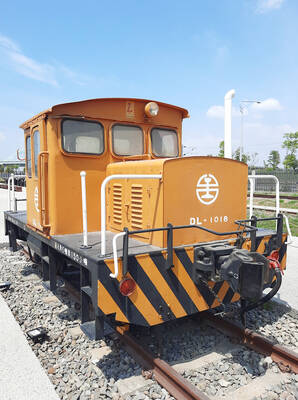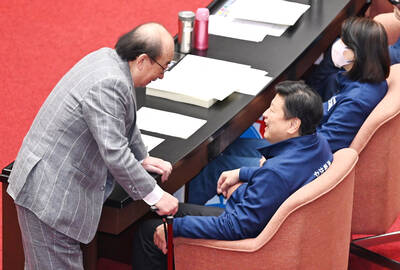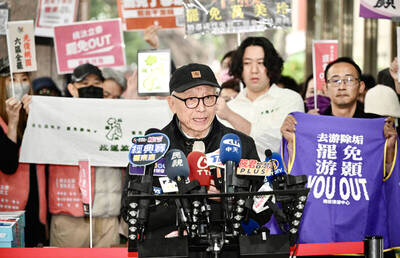The National Palace Museum Tea Ceremony Exhibition (故宮文創系列活動 — 茶事展演) is something new in the annals of this venerable museum. It is a novel departure on many fronts, not least as being the first time guests can partake of tea and snacks as an actual part of the overall experience of art appreciation.
The current exhibition is a pilot project for a cultural creativity center (創意中心) that has been much touted by the National Palace Museum’s recently installed director Chou Kung-shin (周功鑫). Speaking at the opening of the activity at the museum’s Second Exhibition Area in the Library Building (圖書文獻大樓), Chou said that the museum, as the most esteemed and sophisticated cultural conservation agency in the country, would be able to provide a solid basis for the development of Taiwan’s “creative cultural industry” (文化創意產業).
“In Taiwan, we have lots of creative talent, and industry is what we built this country on,” Chou said. “We can provide a foundation that will inject a richer cultural content into the efforts of our young creative artists and entrepreneurs.”
The move is part of a larger effort, which has already seen the establishment of highly successful musical evenings and the creation of a Children’s Gallery, to expand the museum’s role and interact more energetically with contemporary social and cultural developments.
For the current activity, the museum has commissioned the Ren Dan Ru Chu Tea Study Group (人澹如菊茶書院) to create an exhibition on the theme of tea, relating it to both the physical and spiritual environment of the tradition. While the museum’s collection contains many artifacts and paintings related to tea drinking, the current exhibition is housed in seven spaces created by interior designers working together with tea experts and members of the study group.
A CUP OF CALM
Interior designer and curator Chen Cheng-tao (陳正道), in explaining his own exhibit — a simple steel frame hut, the shadow of a tree falling against the wall, a low wooden table placed on a mat floor — said that the environmentally friendly nature of the materials he used, and even the shadow on the wall, were all part of an atmosphere that was integral to creating an environment for appreciating tea and the meditative calm that this activity can induce.
A new student of tea master Li Shu-yun (李曙韻) who was serving as an assistant at the event was effusive about the beauty of the spaces, saying they almost brought tears to her eyes.
The careful combination of materials, light and utensils are designed to suggest poetic atmospheres that stimulate the senses.
“In the workplace, you have to do many things that you might not want to, so you close down your awareness to things,” she said. “Tea appreciation helps you to open up your awareness again, as you focus on subtle things in the act of making and serving tea.”
Some of the spaces are traditionally decorated, ranging from re-creations of traditional Hakka architecture from Beipu (北埔) in Hsinchu County, to highly contemporary affairs, such as one enclosed in a giant transparent plastic bubble and another hung about with reflective strips of material.
SUP AND LEARN
There is plenty to think about in viewing the exhibition, and a free English-language pamphlet available at the door goes some way to explaining the concepts involved.
As with many contemporary art shows in Taiwan, the explanatory notes next to the exhibits, some in poetry form, are excessively abstract.
Volunteers will be on hand every day to answer questions, and there are lectures to be given by tea masters every Friday, Saturday and Sunday until April 18, on subjects such as The Aesthetics of Taiwan Tea Culture (台灣紅茶篇), the Potential of the Taiwanese Tea Room (台灣茶室的可能), and A History of the Changing Flavor of Prize-Winning Dongding Oolong Tea (凍頂比賽茶的變遷史).
A full schedule of the lectures is available on the museum’s Web site (Chinese only) at www.npm.gov.tw/zh-tw/learning/education/education_08.htm?docno=101. Seating for the lectures is limited and bookings are recommended. Call (02) 2881-2021 X2113 to make a reservation.
The Ren Dan Ru Chu Tea Study Group will provide tea and traditional tea snacks in the lobby outside the exhibition area for NT$100, giving visitors a chance to appreciate some tea after they have contemplated the artistry of the seven tea drinking areas.

On Jan. 17, Beijing announced that it would allow residents of Shanghai and Fujian Province to visit Taiwan. The two sides are still working out the details. President William Lai (賴清德) has been promoting cross-strait tourism, perhaps to soften the People’s Republic of China’s (PRC) attitudes, perhaps as a sop to international and local opinion leaders. Likely the latter, since many observers understand that the twin drivers of cross-strait tourism — the belief that Chinese tourists will bring money into Taiwan, and the belief that tourism will create better relations — are both false. CHINESE TOURISM PIPE DREAM Back in July

Taiwan doesn’t have a lot of railways, but its network has plenty of history. The government-owned entity that last year became the Taiwan Railway Corp (TRC) has been operating trains since 1891. During the 1895-1945 period of Japanese rule, the colonial government made huge investments in rail infrastructure. The northern port city of Keelung was connected to Kaohsiung in the south. New lines appeared in Pingtung, Yilan and the Hualien-Taitung region. Railway enthusiasts exploring Taiwan will find plenty to amuse themselves. Taipei will soon gain its second rail-themed museum. Elsewhere there’s a number of endearing branch lines and rolling-stock collections, some

Could Taiwan’s democracy be at risk? There is a lot of apocalyptic commentary right now suggesting that this is the case, but it is always a conspiracy by the other guys — our side is firmly on the side of protecting democracy and always has been, unlike them! The situation is nowhere near that bleak — yet. The concern is that the power struggle between the opposition Chinese Nationalist Party (KMT) and their now effectively pan-blue allies the Taiwan People’s Party (TPP) and the ruling Democratic Progressive Party (DPP) intensifies to the point where democratic functions start to break down. Both

This was not supposed to be an election year. The local media is billing it as the “2025 great recall era” (2025大罷免時代) or the “2025 great recall wave” (2025大罷免潮), with many now just shortening it to “great recall.” As of this writing the number of campaigns that have submitted the requisite one percent of eligible voters signatures in legislative districts is 51 — 35 targeting Chinese Nationalist Party (KMT) caucus lawmakers and 16 targeting Democratic Progressive Party (DPP) lawmakers. The pan-green side has more as they started earlier. Many recall campaigns are billing themselves as “Winter Bluebirds” after the “Bluebird Action”